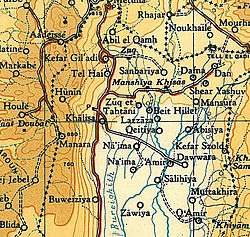Al-Na'ima
| Al-Na'ima | |
|---|---|
 Al-Na'ima | |
| Arabic | الناعمة |
| Subdistrict | Safad |
| Coordinates | 33°11′17.41″N 35°35′41.88″E / 33.1881694°N 35.5949667°ECoordinates: 33°11′17.41″N 35°35′41.88″E / 33.1881694°N 35.5949667°E |
| Palestine grid | 206/288 |
| Population | 1240 (1,340 Arabs and 210 Jews)[1] (1945) |
| Area | 7155[1] dunams |
| Date of depopulation | May 14, 1948[2] |
| Cause(s) of depopulation | Influence of nearby town's fall |
| Current localities | Ne'ot Mordekhay,[3] Kefar Blum,[3] and Beyt Hillel[3] |
Al-Na'ima (Arabic: الناعمة ) was a Palestinian Arab village in the Safad Subdistrict of Mandatory Palestine located 26 kilometres (16 mi) northeast of Safad. The settlement was depopulated during the 1947-1948 civil war on May 14, 1948 by the Israeli Palmach's First Battalion as part of Operation Yiftach.
In 1945 it had a population of 1,240 of whom 210 were Jews.
History
Al-Na'ima was located on flat land to the north west of the al-Hula Plain. A road linked it to the village of al-Khalisa and to a highway leading to Safad and Tiberias. A road linked the village to a highway leading to Safad and Tiberias. A shrine dedicated to local sage al-Shaykh al-Wayzi lay about 0.5 kilometres (0.31 mi) from the site as did a stone quarry.[3] The village also had a boys’ elementary school.[3]
In the 1931 census of Palestine, conducted by the British Mandate authorities, En Na'ima had a population of 858, all Muslims, in a total of 174 houses.[4]

Types of land use in dunams in the village in 1945:[5][6]
| Land Usage | Arab | Jewish |
|---|---|---|
| Irrigated and plantation | 4,122 | 2,197 |
| Cereal | 156 | 217 |
| Cultivable | 4,278 | 2,414 |
| Urban | 112 | 0 |
| Non-cultivable | 60 | 0 |
The land ownership of the village before occupation in dunams:[1]
| Owner | Dunams |
|---|---|
| Arab | 4,450 |
| Jewish | 2,414 |
| Public | 291 |
| Total | 7,155 |
1948, and aftermath
During the 1948 war, Al-Na’ima was depopulated during Operation Yiftach which targeted Safad and the surrounding district. When the city of Safad was finally attacked between the 10 and 11 May 1948, morale in the village was low; according to an Israeli intelligence report, many residents fled on 14 May shortly before advancing Israeli troops entered.[3]
The settlement of Ne’ot Mordekhay was built in 1946 to the south of the village while to the north is the settlement of Beyt Hillel, built in 1940. Kefar Blum, built in 1943 lies 2 kilometres (1.2 mi) to the southeast.[3]
References
- 1 2 3 Government of Palestine, Department of Statistics. Village Statistics, April, 1945. Quoted in Hadawi, 1970, p. 70
- ↑ Morris, 2004, p. xvi, village #19. Also gives cause of depopulation.
- 1 2 3 4 5 6 7 Khalidi, 1992, p. 482
- ↑ Mills, 1932, p. 109
- ↑ Government of Palestine, Department of Statistics. Village Statistics, April, 1945. Quoted in Hadawi, 1970, p. 120
- ↑ Government of Palestine, Department of Statistics. Village Statistics, April, 1945. Quoted in Hadawi, 1970, p. 170
Bibliography
- Esber, Rosemarie M. (2008), Under the Cover of War, The Zionist Expulsions of the Palestinians. Arabicus Books & Media.
- Hadawi, Sami (1970). Village Statistics of 1945: A Classification of Land and Area ownership in Palestine. Palestine Liberation Organization Research Center.
- Khalidi, Walid (1992). All That Remains: The Palestinian Villages Occupied and Depopulated by Israel in 1948. Washington D.C.: Institute for Palestine Studies. ISBN 0-88728-224-5.
- Mills, E., ed. (1932). Census of Palestine 1931. Population of Villages, Towns and Administrative Areas. Jerusalem: Government of Palestine.
- Morris, Benny (2004). The Birth of the Palestinian Refugee Problem Revisited. Cambridge University Press. ISBN 978-0-521-00967-6.
External links
- Welcome To al-Na'ima
- al-Na'ima at Khalil Sakakini Cultural Center
- Al-Na’ima Dr. Khalil Rizk.